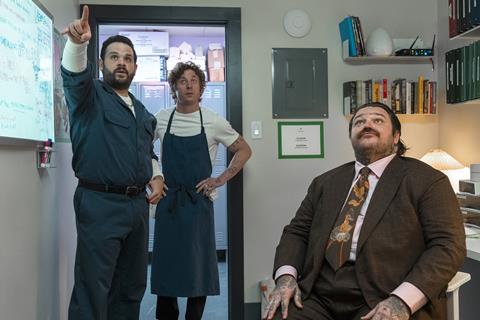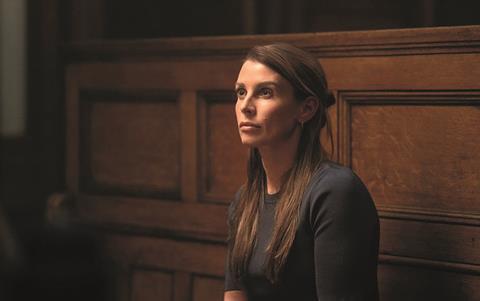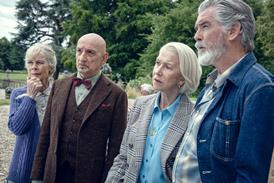Flexibility in terms of content mix, subscriber viewing habits and price points is key to Disney+’s streaming strategy, says the platform’s president
How does a top streaming executive navigate the rollercoaster challenges of the past few years? For Disney+ president Alisa Bowen, one of the key strategies is to remain focused and collected.
“There’s always room for a little more pragmatism and a little more focus on outcomes,” she tells Broadcast from her bedroom office at her home in Los Angeles.
Level-headedness is one of Bowen’s hallmarks. In a feature titled ‘Wonder Women of Los Angeles 2024’ in US trade title Next TV, Disney Entertainment direct-to-consumer chief Joe Earley said of her: “While other people would be worried about politicking, she wanted to get stuff done.”

That approach has been necessary during a period in which the emphasis in global streaming has shifted from subs growth to profitability.
In last year’s quarterly earnings calls, reinstalled Disney chief Bob Iger delivered sombre messages about a “recalibration” of Disney+’s international business, even suggesting that some territories “may not have a service at all”. Yet a year on, Disney has become the first traditional US studio to announce a profit in its direct-to-consumer (D2C) business, coming in $47m (£36.9m) in the black across its streaming portfolio in the third quarter, and predicting further growth this year and beyond.
While the gains are mostly attributed to sports streamer ESPN+, Bowen has a strong sense of opportunity for Disney+ amid all the noise of resets, inflection points and streaming pullbacks.
“Our focus is on scaling our D2C business and continuing to grow it,” she says. “I’m always looking for the opportunity to take the temperature down, focus on what we’re here to do and find a path through.”
A key part of that is building out Disney+’s offering beyond the Marvel, Pixar and Star Wars franchises for which it is best known.
Seizing the opportunity
The service is now armed with 13,000 TV shows and films, spanning 8,000 hours, and all the “general entertainment, adult-skewing” programming created by Disney Entertainment co-chair Dana Walden’s TV group has moved onto the service. In addition, outside the US, it is home to prestige FX on Hulu titles such as Shogun and The Bear, and in terms of UK-produced content, the glossy adaptation of Jilly Cooper’s Rivals from Happy Prince is a high-profile addition.
“More than half the consumption of content on the platform in EMEA is general entertainment”
The effect of this breadth of content has been significant, Bowen says: “Now, more than half of the consumption of content on the platform in EMEA is general entertainment. That’s been huge.”
Another way in which the Disney+ content mix is evolving is via sport. On a corporate level, it is digesting the news that its planned joint venture with US sports streamer Venu, which was set to cost subscribers $43 (£32.76) a month, has been stymied following an anti-competition suit brought by rival provider Fubo TV.
Venu, which was set up in partnership with Fox and a somewhat diminished Warner Bros Discovery (after its high-profile loss of an NBA rights package) has been blocked by a preliminary injunction and the partners are appealing.

But irrespective of that challenge, Bowen talks up the value of sport in a streaming environment. The company is making ESPN central to the Disney+ platform, with its own distinct tile, and is adding more live ESPN sport content to its LatAm offering.
She says: “We’ll soon be launching some live sport in Europe, with the Europa League in the Nordics and other parts of the world where we have access to rights. Sport is another vector of our development and growth.”
Bowen is reluctant to talk about further potential rights acquisitions, flagging that the European market is complex and expensive, making it hard to replicate the well-rounded offering it has in South America of “premium events across a wide range of leagues and sports”.
But she’s clear that live sport is an important future element of a Disney+ strategy that she describes enthusiastically as the “streaming linear experience”. The previously held wisdom that on-demand, binge-watching was the only way modern viewers wanted to consume content has been debunked and while sport is the most obviously attractive form of live content, Bowen says the principle “can sometimes apply to entertainment”.
She explains: “We’re looking at different ways for consumers to engage with the content, whether that’s live streams of entertainment content or the [more deliberate] VoD experience.”
“We want to cater to subscribers who are very intentional in their viewing and those who are much more interested in a browsing experience”
In the US, news and pre-school content are examples of ‘continuous streams’ already offered by Disney+, and Bowen says it is looking at “bundles with other parts of The Walt Disney Company and third parties” too. The plan is to comprehensively cater for different subscribers: both those who are “very intentional in their viewing habits” and know what they want, and those who are “much more interested in the browsing experience”.
The final element of flexibility that Disney+ is aiming to offer subscribers is around price, where (like many of its rivals) it offers a cheaper, ad-supported tier. It is building momentum: Bowen points to offering “more choice for consumers through tiering” as a fundamental strategy for growth. In May 2024, the company reported 22.5 million subscribers to its ad-supported tier, around a fifth of its core subs base at the time.

Bowen, an Australian who was previously chief technology officer at Rupert Murdoch’s News Corp in her native country, initially worked for Disney in the international division. In a media landscape where US performance is the bellwether for the streaming titans, her outsider perspective has been an asset in Hollywood.
She says: “The international perspective has given me the agency to have a voice in Burbank about understanding and empathising with the nuances of what’s happening in all our international regions – everything from consumer tastes and habits to regulatory considerations. That is going to allow us to get the best outcome in those markets as we grow.”
However, Iger’s gloomy forecasts for the international business a year ago still loom large. Bowen acknowledges that an improved financial footing in the D2C business has not necessarily resulted in a “softening” of the rhetoric but points out that Disney+ is “active in local productions in every region in which we operate” and “putting investment behind international continues to be a critical priority”.
The current strategy, she explains, is putting a higher priority on regions and local markets where the majority of Disney+’s subscribers are, such as France, Germany, Spain, the UK and other countries in EMEA – where Disney is investing $1bn (£760.8m) per year across Studios, Disney+, Nat Geo and other TV production.
“We’ve tried a lot of different things in different markets,” she adds. “We’ve tried reaching all areas of the demographic. Now we’re focused on where we think we can be most successful in the near term.
“We’re trying to augment what we offer to the general entertainment adult audience [in these territories], such as broad, accessible, particularly female-skewing, shows.”

Bowen cites Dorothy St. Pictures’ doc Coleen Rooney: The Real Wagatha Story as the type of unscripted content that has broken out of the UK and EMEA.
For other regions, the approach is more tailored. In APAC – a typical streamer target area for growth – there are three key areas: “anime and live action drama in Japan, and adult-skewing drama in Korea”.
“But in every one of these markets outside of EMEA, we’ve had a unique lens into local opportunities and are able to leverage them for our global strategy,” says Bowen. “It’s not as if any of them are on ice. We’re continuing to grow and develop them in every place we operate, while we scale the profitability of the business overall.”
It is instructive that two of Disney+’s biggest international hits – Japanese-language epic Shogun and family restaurant drama The Bear – are not from Disney+’s core US tentpole franchises, but from John Landgraf’s closely curated FX on Hulu division. Both titles triumphed at the Emmys, taking home 29 gongs between them, with Shogun shattering numerous records with its 18-strong haul.
Fresh opportunities
Is there an argument that Disney+ should be focusing on smaller shows outside of the US for its next breakout global hit, and is there a tension that non-superhero, non-space sci-fi content is landing better?
“It’s not a tension, it’s an opportunity,” Bowen says. “Across the board, we’ve been quite upfront about the rebalancing of the content portfolio. Shogun was new IP, a brand-new concept, and not what you might have expected for a mainstream breakout hit in terms of format.”
Disney+ commissioners, she adds, are focused on questions like: “Who is this for? Why are we doing this? What are subscribers interested in? What else are they watching on our service? And, more broadly, who are we trying to bring in with it?”
“Those conversations will inform the content we create between the big, global tentpole drops.”

Operational strategy makes up a significant chunk of Bowen’s workload, and she sits a few layers above its local commissioners on the ground in Disney+ territories. Regional leaders include Luke Kang in APAC, Diego Lerner in LatAm and Jan Koeppen in EMEA - who report into Walden, Alan Bergman and Jimmy Pitaro.
But she stresses that she remains close to content decisions. When Broadcast catches up with her, Bowen is ticking off workload tasks before a long weekend with her family and some R&R by a pool – and just a little work.
“I’ve got four screeners and I’m going to really enjoy them,” she says. “I want to see what’s happening in the creative and I want to know what’s going on.
“From my perspective, as the general business manager, it’s critical to understand what they are, who they appeal to, how they’re going to be marketed, and how they’re going to show up when they come on the service. And that’s hard to do if you haven’t watched the content. We have to know what we’re talking about. I can’t see it all, but I do my best.”
LICENSING DISNEY+ CONTENT
Until as recently as two years ago, it would have been anathema for streaming bosses, particularly at Disney+, to talk about licensing original content to other services. But the giant is now doing deals to distribute titles in a second window. Nautilus, a splashy commission out of the UK, never made it to Disney+, with the company selling it to AMC in the US and France Télévisions, among others. “We’ve always stayed in the licensing business.
Obviously, there was a period during our launch when we were making sure the very best and the complete collection was available on Disney+, and that’s still a priority,” says Bowen. “But there have always been a lot of deals we have with both free-to-air broadcasters and other SVoD players.”
Another significant element is licensing content from third parties. “That’s been very successful for Hulu in the US to build engagement and retention around the original content, and it’s a strategy we are also employing on Disney+,” she says. “We’ll continue to look for opportunities across EMEA, APAC and LatAm.”






























No comments yet